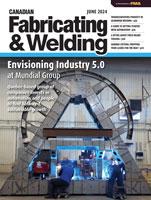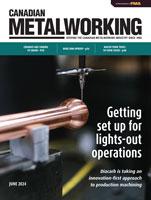Vice-President
- FMA
- The Fabricator
- FABTECH
- Canadian Metalworking
Why lease machine tools?
Consider ROI, total borrowing capacity, tax implications when adding equipment
- By Ken Hurwitz
- May 24, 2024
As we enter open house and tradeshow season, I thought it would be a good time to get back to basics and review and quantify why it’s a good idea to lease new or used equipment.
The reasons for keeping money in your bank account are obvious. In a slow economy, or even when business is good, manufacturers are under pressure from a cash flow perspective. When your shop is busy, employees need to be compensated, overhead must be covered, and material and tooling suppliers must be paid, along with any other services that are required to manufacture your parts.
Once parts are finished and delivered, then there often is a long wait before you get paid, and this is why maintaining a good balance in your corporate bank account is an absolute must. Following are three reasons why I recommend manufacturers choose lease financing instead of tying up valuable working capital in equipment.
1. ROI
Lease equipment and invest money where it will earn the best return.
Machinery and equipment are by nature depreciating assets. Even the finest machine tools have their maximum value the day before they are installed. A smart business owner uses funds for investments that provide the greatest return, which is normally found by reinvesting in their own business through such activities as hiring an additional salesperson.
Many of my most successful clients are owner/operators, so not only are they running the shop and making sure good parts are delivered to their customers when promised, they also are handling all the proposals, quoting, and estimating.
They function as both the sales manager as well as the plant manager, two roles best handled by different individuals. Depending on the business, it could make a lot of sense to hire an individual or promote someone internally to handle the plant manager role.
I can tell you from first-hand experience that business development is a full-time job, but one which provides a great return.
I also have other clients who have grown tired of paying rent, so they have purchased their own unit or, in some cases, an entire building. Investing in property is always a smart decision as it is an appreciating asset, which has the potential of providing a great return.
2. Borrowing Capacity
Leasing allows companies to significantly increase their borrowing capacity.
A leasing company has no intention of replacing your bank. Most of my clients have well-established banking relationships with large operating lines, which they use properly for short-term debt like financing receivables and covering short-term costs like buying tooling and material in lieu of using cash.
These manufacturers use equipment leasing as a complement to their bank and match lenders with their debt requirements to avoid tying up valuable bank lines or working capital in long-term needs like machinery and equipment.
I also have clients who simply can’t use a bank for a large transaction like a machine tool, which can happen for a number of reasons. Buying the latest technology can be a very expensive proposition, and despite the fact good equipment, when maintained properly, will run in a plant for more than a decade, it is still a significant cost and can be challenging for a typical banker to understand, much less approve.
When a leasing company with expertise in machinery and equipment looks at that same transaction, it knows there is significant value in the equipment and that it can recover a significant percentage of the original cost of the machine even if the transaction goes badly. The perceived risk in this type of transaction is much smaller for a leasing company, and it often can approve the lease when a bank declines.
3. Tax Implications
Operating leases are tax friendly.
When a piece of equipment is bought outright, either in cash, bank loan, or a line of credit, the buyer takes immediate ownership, and it becomes an asset on their balance sheet.
From a taxation perspective, asset ownership allows a manufacturer to depreciate the asset, which is essentially expensing a percentage of the equipment cost to reduce operating income and, in turn, pay less tax.
However, if the purchase happens near the end of the year, the tax savings could be minimized because Canada Revenue Agency may not allow a full year’s depreciation to be taken.
Shops looking to reduce tax implications can set up an operating lease for a piece of equipment. This is a contract that allows for the use of an asset but does not convey rights of ownership, the leasing company in fact maintains ownership.
The equipment is not put on the books as an asset, but instead it is accounted for as a rental expense in what is known as off balance sheet financing. This means no assets or liabilities are recorded on the balance sheet.
What I have tried to outline this month is the importance of taking a few additional factors into consideration when deciding how best to arrange financing for a large transaction to help grow your business. There certainly must be a dollars-and-cents attitude when making this decision, but all the relevant aspects such as ROI, increased borrowing capacity, and tax implications should also be considered.
Ken Hurwitz is vice-president of Equilease Corp., 416-499-2449, ken@equilease.com, www.equilease.com.
subscribe now


Keep up to date with the latest news, events, and technology for all things metal from our pair of monthly magazines written specifically for Canadian manufacturers!
Start Your Free SubscriptionAbout the Author

Ken Hurwitz
41 Scarsdale Road Unit 5
Toronto, M3B2R2 Canada
416-499-2449
- Industry Events
MMTS 2024
- June 18 - 20, 2024
- Montreal, QC Canada
RAPID + TCT
- June 25 - 27, 2024
- Los Angeles, CA
IMTS 2024
- September 9 - 14, 2024
- Chicago, IL
WiM Summit 2024
- October 6 - 9, 2024
- Boston, MA
FABTECH 2024 Orlando
- October 15 - 17, 2024
- Orlando, FL





















